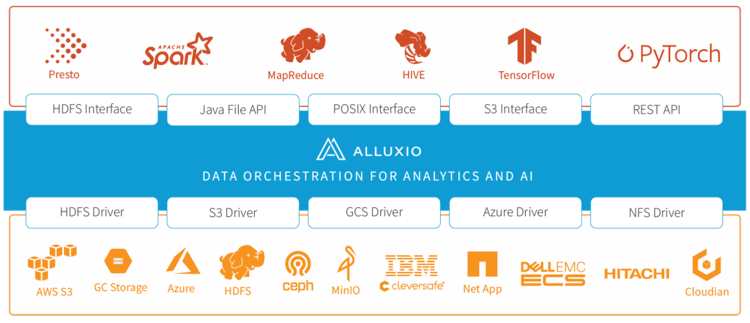Availability of Alluxio Orchestration Platform V.2.9 with Architecture for Multi-Tenant Environments at Scale
Enhancements include scaling out with tenant-level isolation, simplifying DevOps on Kubernetes, and strengthening security of S3 API.
This is a Press Release edited by StorageNewsletter.com on November 24, 2022 at 2:02 pmAlluxio, Inc. announced the availability of its Data Orchestration Platform version 2.9.
This release strengthens its position as the key layer between compute engines and storage systems by delivering support for a scale-out, multi-tenant architecture with a cross-environment synchronization feature, enhanced manageability with improvement in the tooling and guidelines for deploying Alluxio on Kubernetes, and improved security and performance with a strengthened S3 API and POSIX API.
“We have been working with Alluxio on several key projects across our data platform,” said Nirav Chotai, senior DevOps manager, Rakuten Group. “Since our infrastructure is spread across regions, compute engines and storage types, we envision Alluxio will continue to play a critical role to help scale the platform further. We are excited to leverage the latest release with several improvements, especially the new Kubernetes operator for our multi-tenant environment.”
“We are running one thousand nodes of Alluxio to optimize model training jobs and interactive queries,” said Peng Chen, engineer manager, big data team, Tencent. “Alluxio has become the de-facto choice for large Internet companies to accelerate the development of their data analytics and AI applications. We are excited about the enhanced Kubernetes feature of the new release, which will make managing Alluxio even easier.”
“We have been using Alluxio as the data cache layer on top of multiple data centers to speed up the data access performance,” said Luo Li, director, data infrastructure, Shopee. “Alluxio’s architecture enables us to support data ‘servitization.’ Furthermore, Alluxio has reduced our data infrastructure team’s management overhead, especially for data distributed in multiple data centers, or even across countries.”
“Tenant-dedicated satellite clusters have become more common while architecting data platforms,” said Adit Madan, director, product management, Alluxio. “Alluxio’s ability to actively synchronize metadata across multiple environments is significant, making the adoption of such an architecture easier than ever.”
Tenant isolation provides the scale and economic benefits of a multi-tenant architecture while preventing different teams from competing for access to shared data lake storage. With the new cross-environment synchronization feature, the company evolves its architecture with improved scalability and manageability enabling data platform teams to deploy multiple per-tenant Alluxio clusters between compute and storage cluster across any environment, based on workload capacity. Running Alluxio on Kubernetes helps standardize deployment methodologies across cloud, multi-cloud, hybrid-cloud, and on-premises environments. This release introduces the Alluxio operator, which simplifies deploying, configuring, provisioning, and managing multiple Alluxio clusters, reducing DevOps complexity. Alluxio on Kubernetes also makes data stack portable to any environment, preventing vendor lock-in. Lastly, in V.2.9, authentication and access policies are centralized through the communications between compute engines and Alluxio via S3 API. Therefore, the firm provides a unified security experience across heterogeneous storage either on-premise or in the cloud.
“Alluxio’s data orchestration platform aims to simplify, secure, and accelerate data access in heterogeneous analytics environments,” said Kevin Petrie, VP, research, Eckerson Group. “These v2.9 enhancements seek to give new analytics users, applications, and projects the resources they need, with less effort and higher confidence in meeting SLAs. Alluxio does this by helping enterprises manage metadata, containerized deployments, and the security of its APIs more effectively.”
V.2.9 Community and Enterprise Edition features capabilities, including:
-
Multi-environment cluster synchronization – It introduces the cross-environment synchronization feature. This feature makes one Alluxio cluster aware of another cluster by automatically syncing the metadata between clusters. Deploying Alluxio clusters across any environment can achieve tenant-level isolation with the metadata of clusters in sync at scale. This feature is particularly useful when adopting satellite architecture with compute clusters segregated across team-level tenants for isolation. With this new feature, multi-tenant architecture with the company’s solution allows the platform to scale out and onboard new use cases without a central resource bottleneck, ensuring SLAs and simplifying metadata management operations.
-
Extended manageability for Kubernetes – It has added the Alluxio operator for Kubernetes. Administrators can now deploy and manage Alluxio on Kubernetes easily through the newly introduced Alluxio operator with CRD (custom resource definitions). The operator offers configuration management for deployment, connections to under storage, configuration updates, and uninstallation. Using the Alluxio operator removes the burden of deploying the solution on different environments, reduces the amount of manual work and simplifies DevOps when managing multiple instances of Alluxio.
-
Enhanced S3 API security with better user experience – It further strengthens its S3 API providing a unified security model to applications with better user experience. By adopting the open authentication protocol for S3 API, users will be verified before their requests are processed. This new feature allows data platform teams to connect to more advanced identity management systems (such as PingFederate) and leverage SSO to enhance user experience. With a uniform authentication and authorization model, applications connected to Alluxio are portable across on-premises, hybrid or multi-cloud.
Free downloads of V.2.9 open source Community Edition and trials of Enterprise Edition are available.
Resources:
Blog: What’s New in Alluxio 2.9: Multi-Alluxio Synchronization, Kubernetes Operator and Flexible S3 Access Control
Case study: Expedia Group has implemented Alluxio to federate cross-region data lakes in AWS. Alluxio unifies geo-distributed data silos without replication, enabling consistent and high performance with about 50% reduced costs.
Case study: Fortune 50 technology company has successfully implemented Alluxio to achieve a hybrid-cloud strategy, become multi-cloud ready, cut costs, and boost agility.
Alluxio at PrestoCon















 Subscribe to our free daily newsletter
Subscribe to our free daily newsletter

